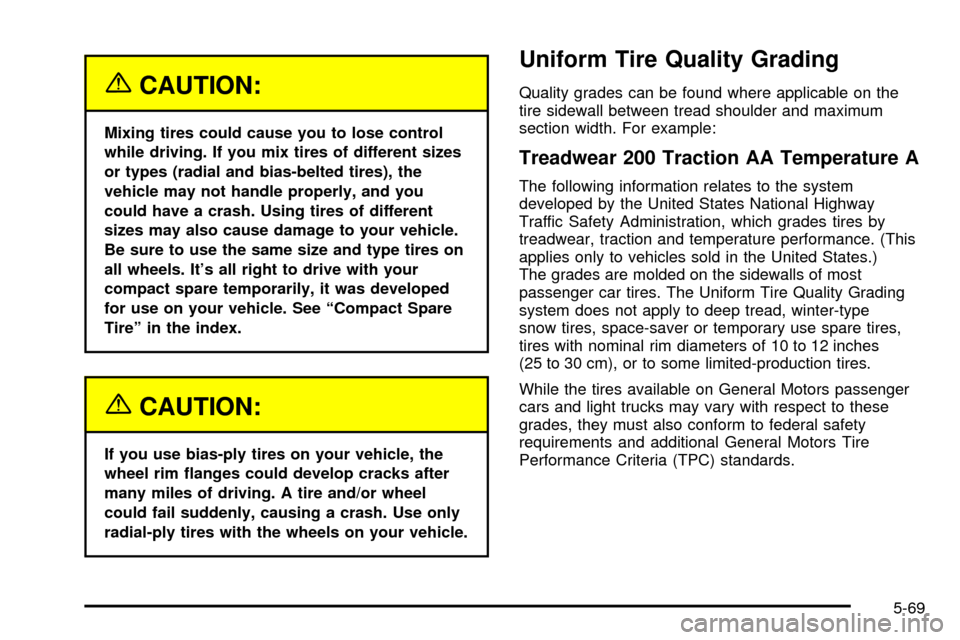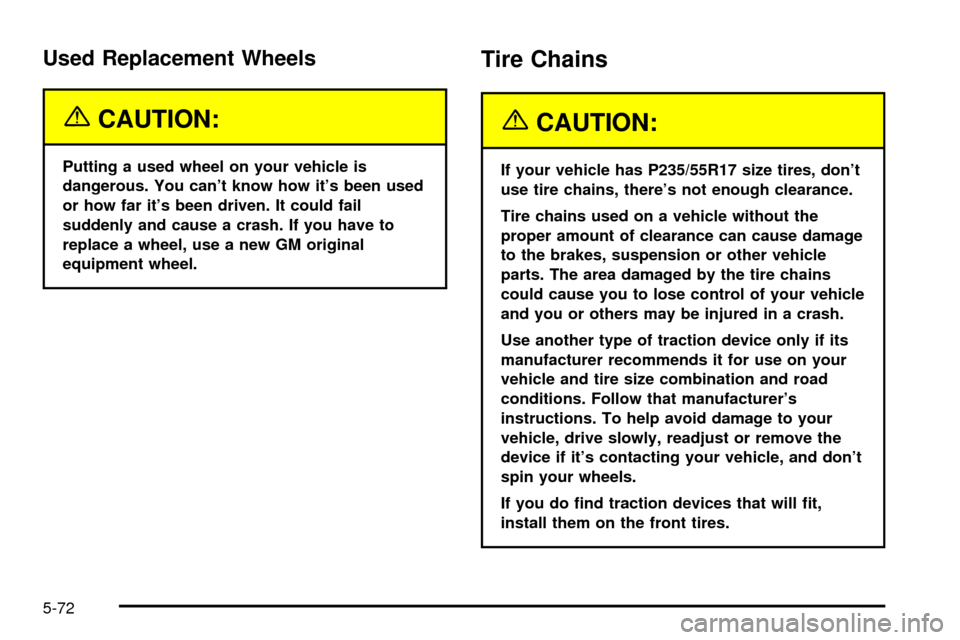2003 CADILLAC SEVILLE traction control
[x] Cancel search: traction controlPage 329 of 408

{CAUTION:
Mixing tires could cause you to lose control
while driving. If you mix tires of different sizes
or types (radial and bias-belted tires), the
vehicle may not handle properly, and you
could have a crash. Using tires of different
sizes may also cause damage to your vehicle.
Be sure to use the same size and type tires on
all wheels. It's all right to drive with your
compact spare temporarily, it was developed
for use on your vehicle. See ªCompact Spare
Tireº in the index.
{CAUTION:
If you use bias-ply tires on your vehicle, the
wheel rim ¯anges could develop cracks after
many miles of driving. A tire and/or wheel
could fail suddenly, causing a crash. Use only
radial-ply tires with the wheels on your vehicle.
Uniform Tire Quality Grading
Quality grades can be found where applicable on the
tire sidewall between tread shoulder and maximum
section width. For example:
Treadwear 200 Traction AA Temperature A
The following information relates to the system
developed by the United States National Highway
Traffic Safety Administration, which grades tires by
treadwear, traction and temperature performance. (This
applies only to vehicles sold in the United States.)
The grades are molded on the sidewalls of most
passenger car tires. The Uniform Tire Quality Grading
system does not apply to deep tread, winter-type
snow tires, space-saver or temporary use spare tires,
tires with nominal rim diameters of 10 to 12 inches
(25 to 30 cm), or to some limited-production tires.
While the tires available on General Motors passenger
cars and light trucks may vary with respect to these
grades, they must also conform to federal safety
requirements and additional General Motors Tire
Performance Criteria (TPC) standards.
5-69
Page 330 of 408

Treadwear
The treadwear grade is a comparative rating based on
the wear rate of the tire when tested under controlled
conditions on a speci®ed government test course.
For example, a tire graded 150 would wear one and
a half (1.5) times as well on the government course as
a tire graded 100. The relative performance of tires
depends upon the actual conditions of their use,
however, and may depart signi®cantly from the norm
due to variations in driving habits, service practices and
differences in road characteristics and climate.
Traction ± AA, A, B, C
The traction grades, from highest to lowest, are AA, A,
B, and C. Those grades represent the tire's ability
to stop on wet pavement as measured under controlled
conditions on speci®ed government test surfaces of
asphalt and concrete. A tire marked C may have poor
traction performance. Warning: The traction grade
assigned to this tire is based on straight-ahead braking
traction tests, and does not include acceleration,
cornering, hydroplaning, or peak traction characteristics.
Temperature ± A, B, C
The temperature grades are A (the highest), B, and C,
representing the tire's resistance to the generation
of heat and its ability to dissipate heat when tested
under controlled conditions on a speci®ed indoor
laboratory test wheel. Sustained high temperature can
cause the material of the tire to degenerate and
reduce tire life, and excessive temperature can lead to
sudden tire failure. The grade C corresponds to a
level of performance which all passenger car tires must
meet under the Federal Motor Vehicle Safety Standard
No. 109. Grades B and A represent higher levels of
performance on the laboratory test wheel than the
minimum required by law.
Warning: The temperature grade for this tire is
established for a tire that is properly in¯ated and not
overloaded. Excessive speed, underin¯ation, or
excessive loading, either separately or in combination,
can cause heat buildup and possible tire failure.
5-70
Page 332 of 408

Used Replacement Wheels
{CAUTION:
Putting a used wheel on your vehicle is
dangerous. You can't know how it's been used
or how far it's been driven. It could fail
suddenly and cause a crash. If you have to
replace a wheel, use a new GM original
equipment wheel.
Tire Chains
{CAUTION:
If your vehicle has P235/55R17 size tires, don't
use tire chains, there's not enough clearance.
Tire chains used on a vehicle without the
proper amount of clearance can cause damage
to the brakes, suspension or other vehicle
parts. The area damaged by the tire chains
could cause you to lose control of your vehicle
and you or others may be injured in a crash.
Use another type of traction device only if its
manufacturer recommends it for use on your
vehicle and tire size combination and road
conditions. Follow that manufacturer's
instructions. To help avoid damage to your
vehicle, drive slowly, readjust or remove the
device if it's contacting your vehicle, and don't
spin your wheels.
If you do ®nd traction devices that will ®t,
install them on the front tires.
5-72
Page 400 of 408

Instrument Panel.............................................3-38
Cluster.......................................................3-38
Overview..................................................... 3-4
Interior Lamps Control.....................................3-21
Interior Lamps................................................3-21
J
Jump Starting.................................................5-45
K
Key in Recall Memory.....................................3-65
Key Lock Cylinders Service..............................6-10
Keyless Entry System....................................... 2-5
Keys............................................................... 2-3
L
Lamps On Reminder.......................................3-17
Lamps...........................................................3-16
Exterior......................................................3-16
Interior.......................................................3-21
Lap-Shoulder Belt...................................1-12, 1-20
LATCH System...............................................1-36
Child Restraints...........................................1-36LATCH System (cont.)
Securing a Child Restraint Designed for the
LATCH System........................................1-38
Leaving Your Vehicle With the Engine Running . . . 2-33
Leaving Your Vehicle.......................................2-11
Lighted Visor Vanity Mirrors..............................2-18
Light.............................................................3-42
Air Bag Readiness.......................................3-42
Anti-Lock Brake System Warning...................3-44
Brake System Warning and Parking Brake
Indicator.................................................3-43
Charging System.........................................3-43
Cruise Control.............................................3-51
Engine Coolant Temperature Warning.............3-46
Fog Lamp..................................................3-51
Lights On Reminder.....................................3-51
Malfunction Indicator....................................3-47
Oil Pressure...............................................3-50
Safety Belt Reminder...................................3-41
Security.....................................................3-51
TCS Warning Light......................................3-45
Traction Control System (TCS) Warning..........3-45
Lights Flash at Lock........................................3-68
Lights Flash at Unlock.....................................3-68
Loading Your Vehicle.......................................4-33
Lockout Protection..........................................2-11
Locks............................................................2-10
Central Door Unlocking System.....................2-10
Door........................................................... 2-9
8
Page 407 of 408

Towing..........................................................4-31
Recreational Vehicle.....................................4-31
Towing a Trailer..........................................4-35
Your Vehicle...............................................4-31
Traction........................................................... 4-9
Control System (TCS).................................... 4-9
Control System Warning Light.......................3-45
Magnetic Ride Control..................................4-11
Trailer Brakes.................................................4-39
Transaxle Operation, Automatic.........................2-28
Transaxle.......................................................5-21
Fluid, Automatic...........................................5-21
Transmission, Transaxle, Transfer Case Unit
Repair Manual............................................7-10
Transportation Options...................................... 7-8
Trip Computer................................................3-77
Oil Life Indicator..........................................3-77
Trip Odometers..............................................3-39
Trunk Lid Tie Down.........................................2-13
Trunk Lock Release........................................2-12
Trunk............................................................2-12
Turn and Lane-Change Signals.......................... 3-9
Turn Signal/Multifunction Lever........................... 3-9
Turn Signals When Towing a Trailer..................4-40
Twilight Sentinel
ž............................................3-19
U
Ultrasonic Rear Parking Assist (URPA)...............3-24
Umbrella Holder..............................................2-49Underbody Flushing Service.............................6-12
Underhood Fuse Block....................................5-93
Understanding Radio Reception.......................3-103
Uniform Tire Quality Grading............................5-69
United States ± Customer Assistance.................. 7-4
Used Replacement Wheels..............................5-72
Using Digital Signal Processing (DSP)...............3-90
Using HomeLink
ž...........................................2-47
V
Valet Lockout Switch.......................................2-20
Vehicle Identi®cation........................................5-91
Number (VIN).............................................5-91
Service Parts Identi®cation Label...................5-92
Vehicle Personalization....................................3-64
DIC ...........................................................3-64
Memory Seat, Mirrors and Steering Wheel......2-51
Vehicle Speed Limiter......................................3-41
Vehicle Storage..............................................5-44
Vehicle............................................................ 4-6
Control........................................................ 4-6
Damage Warnings........................................... iv
Loading......................................................4-33
Symbols......................................................... iv
Ventilation Adjustment......................................3-33
Visors...........................................................2-18
15